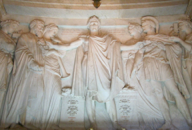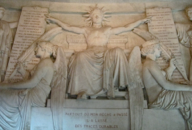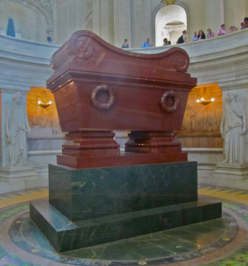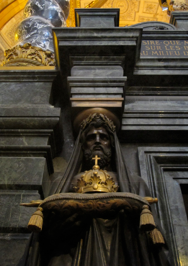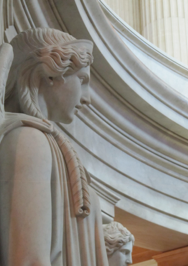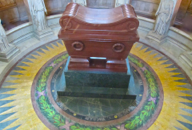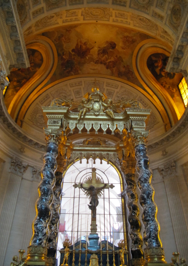Napoleon’s tomb
l’hotel national des invalides
Place invalides
paris, France
europe
June 25, 2010


Napoleon’s tomb
l’hotel national des invalides
Place invalides
paris, France
europe
June 25, 2010


L’Hotel des Invalides, officially named L”Hotel National des Invalides, or “The National Residence of the Invalids” is the final resting place of Napoleon Bonaparte (1769-1821), Napoleon II, Napoleon’s son (1811-1832) , and a whole host of French military heroes. The building complex includes museums and monuments relating to the military history of France, a hospital, and a home for veterans. For years, on my visits to Paris, I have admired the beautiful dome and gardens of these formidable buildings, and probably would not have ventured there this visit had my friend, Janet Gottlieb, not suggested we meet with this as our destination. I was amazed at the scale of the buildings, the elegance of the architecture, the beauty of the interior details, as well as the simplicity and reverence given to the various tombs, the most significant being the tomb of Emperor Napoleon I. Classical references abound, accentuating the strong influence of the French Empire period in terms of European politics, design, architecture, symbolism and fashion during the reign of Napoleon I, Emperor of France 1804-1815. During his reign as emperor he established many governmental and legal reforms, i.e., the Napoleonic Code. Napoleon Bonaparte was considered to be one of the greatest military leaders in history. Though he helped remake the map of Europe, the constant battles that ensued eventually led to his downfall. Napoleon died during his exile on the Island of St. Helena and was buried there in the Valley of the Willows, though he had asked in his will to be buried on the banks of the Seine. In 1840, Louis-Phillippe, King of France, obtained permission from the British to return Napoleon’s remains to France. On December 15, 1840, a state funeral was held. The remains were carried by hearse from the Arc de Triomphe down the Champs-Élysée, across the Place de la Concorde to the Esplanade des Invalides. His tomb was laid in St. Jérome’s Chapel until the newly redesigned site for his tomb, designed by Louis Visconti was completed. The remains were encased in six concentric layers, the outer tomb a red porphyry sarcophagus, placed on a green granite base stands in the central crypt beneath the dome at Les Invalides. It is encircled by a crown of laurels and inscriptions, reminders of the great victories of the Empire. Around the gallery, in a series of bas relief sculptures by Simart, Napoleon Bonaparte is represented in classical style, depicting the main actions of his reign. A statue of the emperor bearing the Imperial emblems stands at the back of the crypt. At his feet, is the burial place of the body of his son by Marie Louise of Austria, Napoleon II. The child, only 4 years of age, was given then title of “Emperor”. This title was held for only two weeks, given as a political strategy by Napoleon loyalists during his father’s 10 month exile in Elba in 1815. Adolph Hitler gave this body, sans heart and intestines, to France as a gift in 1940, one century after Napoleon I’s remains were returned from St. Helena, and the year of the German occupation of France.
PHOTOS: Left Column: 1. The altar of the Dome Church. 2. White marble figures, classical caryatids, surrounding the Tomb of Napoleon beneath the dome of the Dome Church in the Hotel des Invalides. 3. A sculpture of Napoleon II, placed in a classically architected chamber near the Napoleon’s tomb. The figure is depicted wearing a gold trimmed toga in the aristocratic Roman style. Center, Top: The gilt-trimmed dome of the Dome Church in the Hotel des Invalides. Center, Middle: View of the ceiling frescoes painted on the underside of the dome of the Dome Church in the Hotel des Invalides. Center, Bottom: Napoleon’s Tomb in the central crypt of the Dome Church at the Hotels des Invalides. Inside the sarcophagus, the emperor’s remains are protected by six coffins, one inside the other. Right Column: 1. A male caryatid carved in charcoal gray colored marble. This figure supports the baldaquin of the altar at the Dome Church at the Hotel des Invalides. 2. Deeply carved white marble bas reliefs portraying Napoleon as the incarnation of the sun. 3 Deeply carved white marble bas reliefs portraying Napoleon as the King of Rome. He is surrounded by Roman military figures and philosophers in classical Roman attire. 4. Detail: Inlaid marble floor design portraying the crown of the Roi de Rome. The same image is held three-dimensionally by the caryatid in the above photo, #1. 5.View of the central crypt of the Dome Church at the Hotel des Invalides. The sunburst floor and wreath are classical symbols appropriated as a stylistic ideal during Napoleon’s reign.


Military History of France
